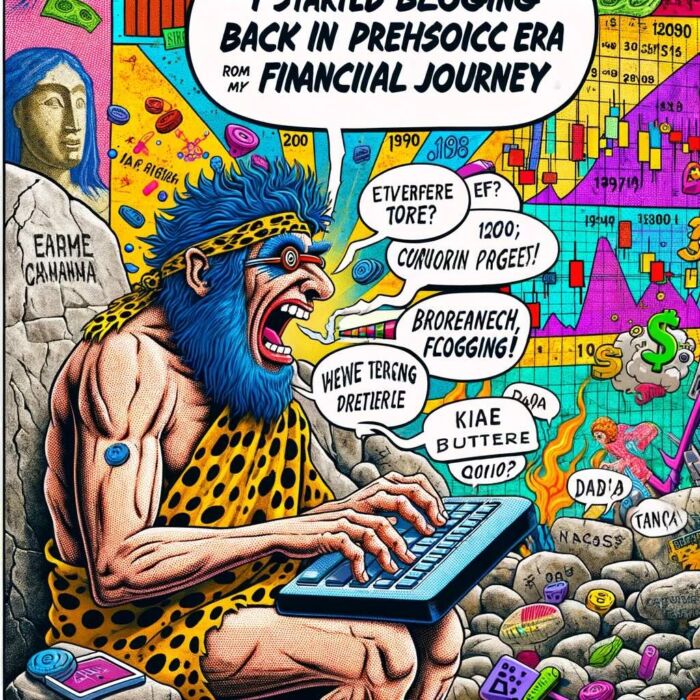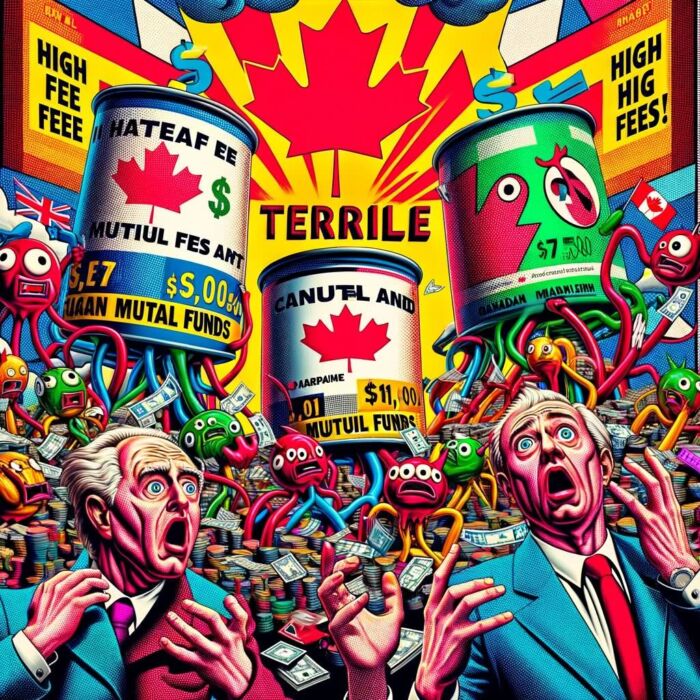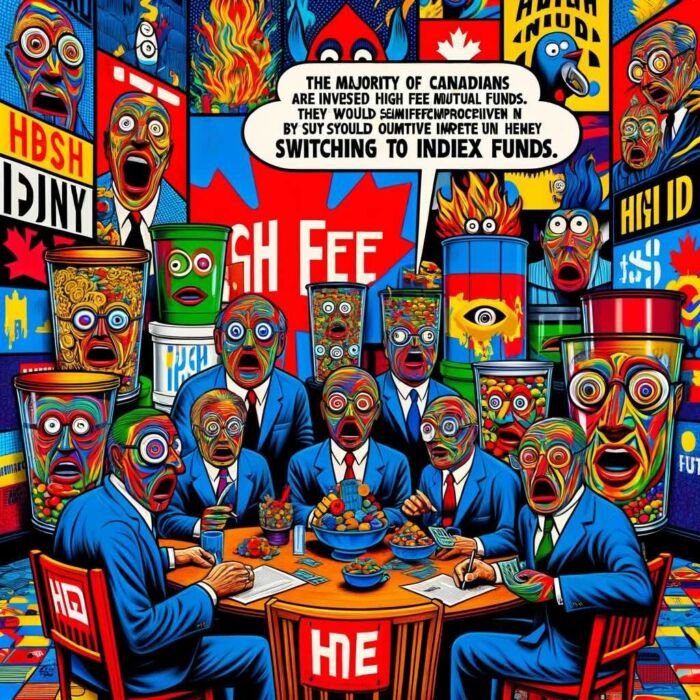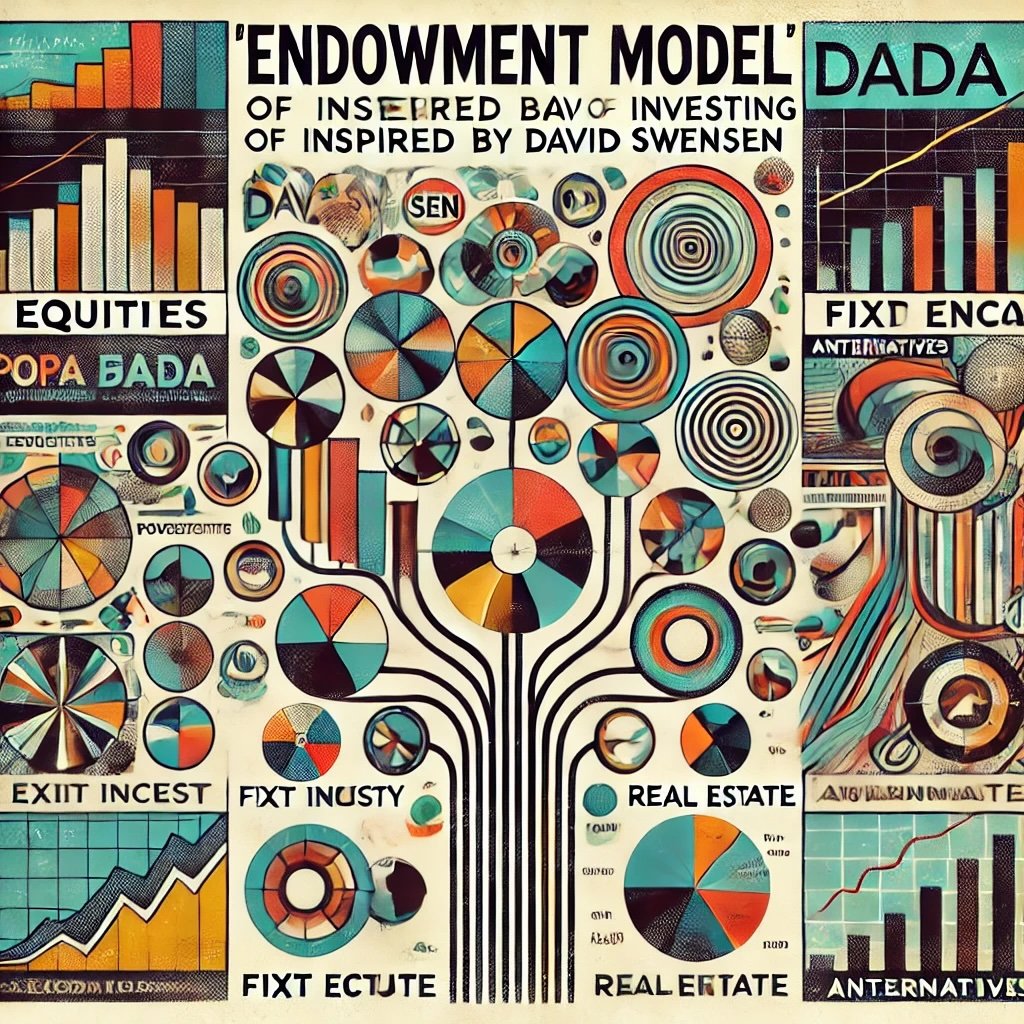As we continue the “How I Invest” series, we’ll explore how you can buy the entire market for as cheap as possible (via a low cost all-in-one asset allocation allocation ETF) and then move on with your life.
Connecting with other investors has been one of the greatest perks of starting Picture Perfect Portfolios.
It’s fascinating to see that Robb Engen started his highly successful investing blog “Boomer & Echo” around the same time I started my travel blog and YouTube channels.
For those not aware of what it takes to turn a passion project into a successful business I’ll sum it up in two words.
Herculean effort.
Oh.
And patience too.
Given Robb’s extensive experience as a personal finance blogger and financial planner, I’m excited to share this “How I Invest” interview with you.

Robb Engen of Boomer & Echo

My name is Robb Engen and I’m an advice-only financial planner and personal finance blogger at Boomer & Echo.
I started blogging back in the prehistoric era (2010) to document my financial journey, share tips that I learned, as well as pitfalls for others to avoid.

I’m a 43-year-old married father of two girls and currently live in Lethbridge, Alberta.
In addition to my financial planning business and my blog, I’ve also been a freelance writer for many years, including a regular column at the Toronto Star and at MoneySense.

Low Cost Total Market Portfolio + Enjoy Life = Robb’s Investing Plan

Hey guys! Here is the part where I mention I’m a travel content creator! This “How I Invest” interview is entirely for entertainment purposes only. There could be considerable errors in the data I gathered. This is not financial advice. Do your own due diligence and research. Consult with a financial advisor.
Source: YouTube via Rational Reminder Podcast Channel (The investment performance results presented here are based on historical backtesting and are hypothetical. Past performance, whether actual or indicated by historical tests of strategies, is not indicative of future results. The results obtained through backtesting are only theoretical and are provided for informational purposes to illustrate investment strategies under certain conditions and scenarios.)
These asset allocation ideas and model portfolios presented herein are purely for entertainment purposes only. This is NOT investment advice. These models are hypothetical and are intended to provide general information about potential ways to organize a portfolio based on theoretical scenarios and assumptions. They do not take into account the investment objectives, financial situation/goals, risk tolerance and/or specific needs of any particular individual.

Robb’s Greatest Investing Influences
Who were your greatest influences as an investor when you first started to get passionate about the subject?
How have your views evolved over the years to where you currently stand?
If you had to recommend a handful of resources (books, podcasts, white-papers, etc) to bring others up to speed with your investing worldview what would you recommend?
My investing experience has been an interesting one.
I started out like most Canadians putting money away into high fee mutual funds (albeit with an employer-match) before I left that job in 2009 and moved my money to a discount brokerage where I began purchasing dividend paying stocks.

I was influenced by Norm Rothery’s dividend “all-stars” that were always featured in MoneySense.
I also read a lot of Tom Connolly, the dividend growth investing guru.
I’d say my portfolio was a mix of Beat the TSX stocks (higher dividend yield stocks), along with several dividend growth stalwarts (lower yield, high growth rate).
I was reading a lot of Dan Bortolotti (Canadian Couch Potato) and other index investing afficionados, and while the idea of index investing was appealing, I couldn’t bring myself to move to a multi-ETF portfolio.
I read a lot of comments on Dan’s blog and on Reddit from small investors who were obsessing over the ideal portfolio (what percentage for Canadian stocks, how much in REITs, should I add gold), meanwhile they have $10,000 to invest.
I didn’t want to tinker.
But I was on my way to being convinced that indexing was the way to go.
Not only was there more than 60 years of academic and empirical evidence to persuade me, I also became aware of my own behavioural biases after reading books such as Thinking, Fast and Slow by Daniel Kahneman.
I needed to get out of my own way and move on to more important aspects of my life, like my family and my career.
The catalyst for change was when Vanguard introduced its All-World ex Canada ETF (VXC).
I decided then to sell my 25 Canadian dividend stocks worth about $100,000 at the time and invest in a two-ETF solution of VCN (Canadian equities) and VXC (everything else).
Finally, Vanguard once again changed the game (for me) when it launched its suite of asset allocation ETFs, including the all-equity VEQT.
I sold my two ETFs and immediately bought VEQT. That was in January 2019, and I haven’t looked back.
My biggest influences now would include the PWL Capital teams of Dan Bortolotti and Justin Bender (their blogs, podcasts, and Justin’s YouTube channel), Ben Felix’s Common Sense Investing YouTube channel, and Ben Felix and Cameron Passmore’s Rational Reminder podcast.
Dan’s “Reboot Your Portfolio” book is also excellent.

Events The Shaped Robb’s Investing Viewpoint
Aside from investing influences, what real life events have molded your overall views as an investor?
Was it something to do with the way you grew up?
Taking on too much risk (or not enough) early on in your journey/career as an investor?
Or just any other life event or personality trait/characteristic that you feel has uniquely shaped the way you currently view yourself as an investor.
Education.
Travel.
Volunteering.
A major life event.
What has helped shape the type of investor you’ve become today?

I figured out after about five years of stock picking that this wasn’t the right path for me.
I did track my returns and compare them to a benchmark index.
But I found myself running out of new ideas for stocks to buy, obsessing over quarterly earnings and company news, and feeling regret when some of my stocks were in the red (looking at you, oil & gas stocks).
The idea of simply buying the entire market for as cheap as possible and then moving on with your life sounded pretty good.

I already had a good savings rate and a good income.
I transitioned from full-time work + side hustle to a full-time entrepreneur doing something I’m passionate about (helping people achieve their financial goals).
The idea of obsessing over 5-10 basis points of fee reduction or finding the perfect portfolio (sorry!) did not appeal to me.
Besides, I like to say I’m an emotionless robot when it comes to investing.
As a single ETF investor, I barely look at my portfolio or the overall market.
I don’t get FOMO when other indexes, sectors, or asset classes are performing better, and I don’t feel regret when my own portfolio is on a downswing.
Sticking to my plan and making regular contributions just comes naturally to me.
As someone who can now work from anywhere with an internet connection, I’m interested in travelling 6-8 weeks per year and finally got a chance to do so this year.
To do that, I need to automate and simplify as much as possible.
This one-fund solution is ideal for my lifestyle.
Source: YouTube via Jason Periera Channel

Conversation With Your Younger Self
Imagine you could have a three hour conversation with your younger self.
What would you tell the younger version of yourself in order to become a better investor?
Something that you know now that you wish you knew back then.
I’m not sure I would tell my younger self to do anything different.
I like the way things unfolded – it shaped who I am today.
Now when I speak to my clients or other investors about stock picking, I can see it from their point of view, and I can also talk with experience about the transition to indexing and how that has improved my life for the better.
The investing landscape was much different back then.
I started contributing to my RRSP at a very young age, but that’s because the TFSA didn’t exist back then.
And the transition from high fee mutual funds to individual blue-chip dividend paying stocks made sense back in 2008/09 when we knew very little about ETFs and the products weren’t as evolved as they are now.
I transitioned to indexing almost exactly as new products came out that made it easier to manage your own portfolio of ETFs.
If that didn’t happen, who knows if I would have made the switch.
Ben Felix likes to say that investing has been solved with low-cost indexing.
My own addition to that is investing complexity has been solved with asset allocation ETFs.

It’s never been easier for young investors to build and manage their own portfolios today without going through the sometimes painful transition of moving from high fee mutual funds and/or individual stock picking.

Robb’s Own The Total Stock Market Portfolio
Let’s pop the hood of your portfolio.
What kind of goodies do we have inside to showcase?
Spill the beans.
How much do you got of this?
Why did you decide to add a bit of that?
If you’d like to go over every line-item you can or if would be easier to break your portfolio into categories or quadrants that’s another route worth considering.
When do you anticipate this portfolio performing at its best?

I literally hold VEQT across all my accounts, including my RRSP, TFSA, locked-in retirement account (LIRA) and my corporate investing account.
That’s it.
I expect long-term returns of 6-8% after fees.
By owning the total global stock market I should increase the reliability of my returns and reduce the volatility (versus holding, say, just the US stock market).

At its best, VEQT is capturing the returns of the total market when stocks are soaring.
At its worst, VEQT is capturing the returns of the total market when stocks are tanking.

Emotionless Robot = Investor Advantage
What kind of investing skills (trading, asset allocation, investor psychology, etc) are necessary to become good at the style of investing you’re pursuing?
Is there a certain type of knowledge, experience and/or personality trait that gives one an advantage running this type of portfolio?

I think the “emotionless robot” I alluded to earlier is a good personality trait to have for someone using a single asset allocation ETF.
There will always be an investment that is performing better.
The trick is to convince yourself that you would never have known in advance which one would outperform, so thinking about that is futile.
To help put this in perspective I like to check out the periodic table of investment returns every year.
With few exceptions, the worst performing assets one year tend to become the best performing assets the next year.
But that is so counterintuitive to our human nature it would be impossible to design an investing strategy around that approach.
That’s why I see it as capturing all of the returns without trying to guess which country, region, or sector will outperform in the future.

More Aggressive and Conservative Portfolio
What would be a toned down version of your portfolio?
Something that’s a bit watered down.
Conversely, what would be a more aggressive version of your portfolio, if someone were willing to take on more risk for a potentially greater reward?
I don’t think it gets any more vanilla than a single asset allocation ETF like VEQT.
You could water it down from an expected return profile by going with the 80/20 (VGRO) or 60/40 (VBAL) versions.
Alternatively, if you like the idea of investing in the total market but just cannot bring yourself to open a discount brokerage account and learn how to trade ETFs then I suppose a robo-advisor would be a decent alternative solution (albeit with higher fees and sometimes suspect asset mixes).

A more aggressive version would be Justin Bender’s “ludicrous” portfolios where you hold multiple ETFs, including US-listed ETFs, to reduce the overall MER.
The trade-off is time, complexity, and adding foreign currency risk.
Finally, a step further would be Ben Felix’s five-factor portfolio where you tilt the portfolio towards small cap and value stocks.
Again, the trade-off comes with time and complexity, but also the bet that small cap and value will not only deliver a premium but that you’ll stick with the strategy long enough to capture it.

Robb’s Greatest Strengths/Weaknesses As An Investor
What do you feel is your greatest strength as an investor?
What is something that sets you apart from others?
Conversely, what is your greatest weakness?
Are you currently trying to address this weakness, prevent it from easily manifesting or simply doubling down on what it is that you’re great at?
Knowing myself and designing an investing approach that emphasizes my strengths and tries to negate my weaknesses.
I can have an addictive / obsessive personality.

I could see that come out when I was a stock picker. If I tried to go down the factor investing approach, or the multi-ETF approach, I could easily see falling victim to my own behavioural biases and messing around too much with my portfolio.
I see two weaknesses in this approach.
One is understanding that I’m only capturing one risk premium (market) and ignoring size and value (among others).
The other is that it’s more expensive to own an asset allocation ETF than it is to break that up into multiple ETFs.
At some point, the size of my portfolio will make the cost savings much more compelling of a trade off than it is now.

Not Obsessing Over A Few Basis Points
What’s something that you believe as an investor that is not widely agreed upon by the investing community at large?
On the other hand, what is a commonly held investing belief that most in the industry would agree with that rubs you a bit differently?
That simple is better than complicated.
My work with what I’ll call average Canadians has made me appreciate that obsessing over a few basis points of cost or arguing about factors versus total market indexing is a privilege for highly sophisticated investors.
The majority of Canadians are invested in high fee mutual funds.
They would significantly improve their outcomes by simply switching to index funds.

I think it’s a stretch to get the average investor to move all the way from active management (mutual funds or stock picking) to owning a multi-ETF portfolio and sticking with it long enough to see the payoff.
A commonly held belief in the industry is that investors need to move to some sort of income producing portfolio in retirement, when I think it’s perfectly sensible to hold a one-fund ETF and take a total return approach to your retirement income.
Source: YouTube via MapleMoney Channel

Eager To Learn More About Behavioural Finance
What’s a subject area in investing that you’re eager to learn more about?
And why?
If you knew more about that particular topic would it influence the way you’d construct your portfolio?
I’m still interested in the behavioural side of finance, especially when it comes to investing.
Why we make the decisions we make, why we chalk up our wins to skill and our losses to bad luck, why we listen to market pundits when we know that markets are unpredictable, and no one has a crystal ball.

I’m not sure knowing more about this would influence my own portfolio construction but it would be beneficial in my work with financial planning clients to help improve their outcomes.
I’m also interested in learning more about product development in the retirement income space.
There was the Purpose Longevity Fund that launched a few years ago, and now more recently the Guardian GuardPath Modern Tontine that addresses human longevity.
I find that fascinating, but know very little about it right now.

Avoiding High Fee Mutual Fund Portfolio
What would be the ultimate anti-Robb portfolio?
Something you’d never own unless you were duct-taped to a chair as a hostage?
What about this portfolio is repulsive to you?
Conversely, if you were forced to Steel Man it, what would potentially be appealing about the portfolio to others?
What is so alluring about it?

I mean, the ultimate anti-Robb portfolio would be the typical Canadian high fee mutual fund portfolio.
It’s criminal that banks and other investment firms can charge 2%+ for what amounts to a closet index fund – and the average investor is pretty clueless about it.

That said, I don’t think there is anything wrong with a new investor getting started that way – most of us don’t know any better than to just head down to the local bank branch and start setting up contributions.
It’s your savings rate that matters more than the fees or rate of return when you’re young and your portfolio is small.
But eventually you’ll need to get out of those high fees.
I think Justin Bender’s ludicrous ETF portfolio with appropriate asset location along with lower MER on US listed ETFs could be interesting at a certain portfolio size.
To be clear, I am against using this asset location strategy right now and prefer to keep things simple by holding the same asset mix across all accounts.
But at a certain portfolio size the potential cost savings and tax savings could be too significant to ignore.

Buy The Entire Market For As Cheap As Possible And Then Move On With Your Life — 12-Question FAQ
What is the core idea behind this approach?
Own the whole market through a low cost, broadly diversified all-in-one ETF and then focus your energy on life instead of constant portfolio tinkering.
Why choose a single asset allocation ETF?
It automates global diversification, rebalancing, and asset mix in one ticker, reducing mistakes and decision fatigue while keeping costs low.
What did Robb Engen personally move to?
He simplified into an all-equity asset allocation ETF (VEQT) across all accounts after moving from dividend stocks to a two-ETF solution and then to one fund.
What return and volatility should investors expect?
Long-term stock-like returns with full participation in market ups and downs. Expect multi-year drawdowns but a simple process that helps you stay invested.
How does this compare with a multi-ETF or factor-tilted portfolio?
Multi-ETF and factor tilts may lower fees or target premiums, but add complexity and behavior risks. The one-fund route prioritizes simplicity and adherence.
When might a more conservative option be preferable?
If you want a smoother ride, consider balanced versions like 80/20 or 60/40 all-in-one ETFs instead of the all-equity choice.
Is a robo-advisor a reasonable alternative?
Yes for some investors, though fees are typically higher and asset mixes can vary. The key is picking a solution you will actually stick with.
What are the main risks of the one-fund route?
You capture full market volatility, miss potential factor tilts, and may pay slightly more than assembling multiple ETFs yourself at scale.
How important are tiny fee differences?
They matter less than savings rate, behavior, and staying the course. For many investors, obsessing over a few basis points is a distraction.
How does this approach support lifestyle goals?
It minimizes time and attention on investing so you can automate contributions, travel, work, and live without portfolio micromanagement.
What behavioral traits help this strategy succeed?
An emotionless, rules-first mindset: ignore FOMO, resist tinkering, contribute regularly, and follow a simple written IPS.
Who should avoid this approach?
Investors who crave hands-on management, factor tilts, or complex tax and asset-location strategies may prefer a multi-ETF or advisor-led plan.
How You Can Follow Robb
Blog: Boomer and Echo – Financial Freedom At Any Age
Twitter: @BoomerandEcho and @RobbEngen
%22%20transform%3D%22translate(1.6%201.6)%20scale(3.125)%22%20fill-opacity%3D%22.5%22%3E%3Cellipse%20fill%3D%22%23d5446e%22%20rx%3D%221%22%20ry%3D%221%22%20transform%3D%22matrix(-8.91021%20127.422%20-55.8935%20-3.90845%20123.2%2052.3)%22%2F%3E%3Cellipse%20fill%3D%22%23000300%22%20cx%3D%2212%22%20cy%3D%22186%22%20rx%3D%2226%22%20ry%3D%22238%22%2F%3E%3Cellipse%20fill%3D%22%23236cb2%22%20rx%3D%221%22%20ry%3D%221%22%20transform%3D%22matrix(-28.13107%20-.18712%20.5742%20-86.32243%2061.4%20110)%22%2F%3E%3Cellipse%20fill%3D%22%23000700%22%20rx%3D%221%22%20ry%3D%221%22%20transform%3D%22matrix(-32.17856%20-3.6094%2028.28615%20-252.1767%20239.5%20149)%22%2F%3E%3C%2Fg%3E%3C%2Fsvg%3E) Nomadic Samuel Final Thoughts
Nomadic Samuel Final Thoughts
I want to personally thank Robb Engen for taking the time to participate in the “How I Invest” series by contributing thoughtful answers to all of the questions!
If you’ve read this article and would like to take part in the “How I Invest” interview series feel free to reach out to nomadicsamuel at gmail dot com.
Robb highlighted one of the biggest differences between the US and Canadian ETF marketplace.
Or what we call all-in-one funds.
They’re all the rage north of the border and they’ve allowed Canadian investors to literally have one click portfolio solutions for whatever stock/bond configuration they’re targeting ranging from all equity to 20/80.
Why they haven’t caught on more in the US is certainly perplexing.

That’s all I’ve got!
Ciao for now!
Important Information
Comprehensive Investment Disclaimer:
All content provided on this website (including but not limited to portfolio ideas, fund analyses, investment strategies, commentary on market conditions, and discussions regarding leverage) is strictly for educational, informational, and illustrative purposes only. The information does not constitute financial, investment, tax, accounting, or legal advice. Opinions, strategies, and ideas presented herein represent personal perspectives, are based on independent research and publicly available information, and do not necessarily reflect the views or official positions of any third-party organizations, institutions, or affiliates.
Investing in financial markets inherently carries substantial risks, including but not limited to market volatility, economic uncertainties, geopolitical developments, and liquidity risks. You must be fully aware that there is always the potential for partial or total loss of your principal investment. Additionally, the use of leverage or leveraged financial products significantly increases risk exposure by amplifying both potential gains and potential losses, and thus is not appropriate or advisable for all investors. Using leverage may result in losing more than your initial invested capital, incurring margin calls, experiencing substantial interest costs, or suffering severe financial distress.
Past performance indicators, including historical data, backtesting results, and hypothetical scenarios, should never be viewed as guarantees or reliable predictions of future performance. Any examples provided are purely hypothetical and intended only for illustration purposes. Performance benchmarks, such as market indexes mentioned on this site, are theoretical and are not directly investable. While diligent efforts are made to provide accurate and current information, “Picture Perfect Portfolios” does not warrant, represent, or guarantee the accuracy, completeness, or timeliness of any information provided. Errors, inaccuracies, or outdated information may exist.
Users of this website are strongly encouraged to independently verify all information, conduct comprehensive research and due diligence, and engage with qualified financial, investment, tax, or legal professionals before making any investment or financial decisions. The responsibility for making informed investment decisions rests entirely with the individual. “Picture Perfect Portfolios” explicitly disclaims all liability for any direct, indirect, incidental, special, consequential, or other losses or damages incurred, financial or otherwise, arising out of reliance upon, or use of, any content or information presented on this website.
By accessing, reading, and utilizing the content on this website, you expressly acknowledge, understand, accept, and agree to abide by these terms and conditions. Please consult the full and detailed disclaimer available elsewhere on this website for further clarification and additional important disclosures. Read the complete disclaimer here.


 Nomadic Samuel Final Thoughts
Nomadic Samuel Final Thoughts



Hey! now markets are falling and SNP500 is around 3600$. Is it cheap enough to buy now? Or you are waiting deeper?
Great article, thanks for that!
I believe for 99,9% of all investors, dollar-cost leveraging into an all-World ETF is the best strategy. It’s low cost, and easy.
For those of us belonging to the 0,1% however, it’s also really boring. I love researching and trying to find the best buy-and-hold-forever stocks I can. I built myself an All-Weather Portfolio of about 40 such stocks, and simply love it seeing all those dividends coming in every week. But again, that’s only if you really are a DIY investor.
Cheers from Singapore,
Noah
What do you think about Robert Kiosaki’s work?